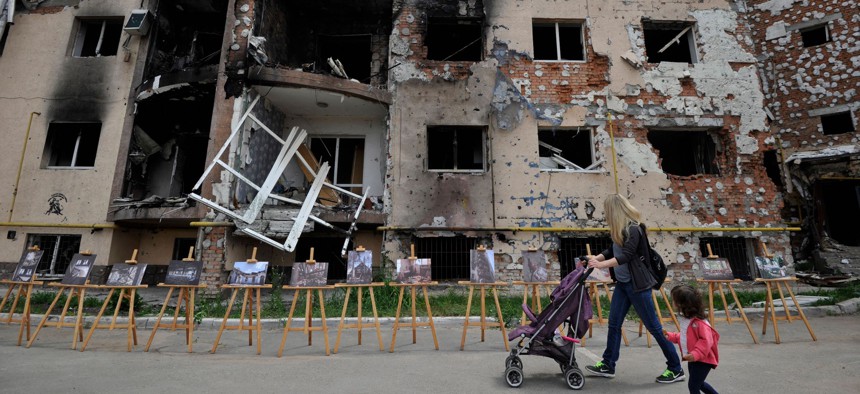
A woman and her daughter walk past a residential building destroyed as a result of shelling in town of Irpin, near the Ukrainian capital of Kyiv on June 16, 2022. AFP via Getty Images / SERGEI CHUZAVKOV
NATO Needs to Move Protection of Civilians to Center Stage
The Ukraine war shows why the alliance’s upcoming summit cannot give short shrift to the topic of human security.
The wrenching images and stories from Ukraine should spur NATO—a trans-Atlantic, defensive, military and political alliance—to think harder about how it would protect its citizens and critical infrastructure during a high-intensity, state-on-state conflict. Alliance leaders would be wise to press this point during the upcoming summit in Madrid, where the organization is slated to adopt a new strategic concept and agree on a definition of human security.
Civilians have always suffered in wartime, and even before Russia invaded Ukraine, it had become clear that a new war on European soil would be no different. Tabletop exercises we participated in over the years—including one last fall that our organization helped to design—point to the fact that defeating the adversary will remain a critical task. However, protecting alliance civilians and civilian infrastructure is likely to be equally important—and perhaps more challenging.
Ukraine's tragic experience only underlines this. Its people are being killed by the Russian shelling of residential neighborhoods, forcibly displaced to Russia, and subjected to more atrocities. But they also die from lack of access to basic needs such as food, water, shelter, healthcare, and electricity. In a future conflict, countering these deadly threats will require a keen understanding of the human environment and the protection of civilians.
NATO adopted a PoC policy at the 2016 Warsaw Summit, and the alliance has since worked to implement the policy. But more work is left to be done. As a military matter, NATO must take attacks on civilians and their needs into account. But there is a political dimension as well. The alliance must publicly demonstrate its commitment to human security to maintain public support and serve as an enduring counterweight to authoritarianism. There is much the alliance can do now to prepare for future conflict and crisis, including by recognizing the unique importance of the protection of civilians in NATO core tasks, future missions and activities, and committing political support to and resources for further development of capabilities.
Given the current security environment, alliance leaders should accelerate work on further implementation of the protection-of-civilians policy, including sufficiently resourcing and integrating it across military functions, including intelligence, planning, training, and doctrine development. First, allies should agree to a definition of human security, reference it in the new strategic concept, and codify all cross-cutting topics in NATO protection-of-civilians policy. This critical step provides the foundation from which future implementation work can take place. Next, allies should begin working on a new action plan to implement the policy. The tasks set out in the first action plan, issued in 2017, have essentially been completed. However, a new action plan will ensure political support, including proper resources, to continue to develop future capabilities.
These policy statements should be followed with tangible measures to ensure an enduring shift in practical implementation. For example, NATO should include protection-of-civilians training objectives in all NATO exercises, including those focused on Article 5. Also, as NATO has no standing military but instead relies on the contributions of its allies and partners, the alliance would benefit from a mapping of ally and partner national policy and best practices.
NATO's high-profile commitment to human security can signal similar changes to integrate this approach into allied militaries. Some countries are further along on this than others, but an alliance-wide approach will serve as a baseline and guide how they fight together under a NATO umbrella, which will be essential in a crisis. Allies, too, should incorporate a firm understanding of human security and protection of civilians into national training and doctrine development.
Finally, as much expertise on human security lies outside the alliance, allies should consider establishing a standing Human Security Experts Group to provide external input and advice on NATO's evolving approach. Just as it is important to establish key relationships with external actors in a battlespace, NATO should work to standardize the way in which experts in this area are welcomed into alliance discussions and work flows.
This increased focus on human security is both critical and overdue. In interview after interview, Ukraine's president Volodymyr Zelensky has reminded us that a nation—or an alliance of nations—is not just about its land; it is first and foremost about its people.
Marla Keenan and Andrew Hyde are adjunct senior fellows at the Stimson Center. Previously, Marla served as the senior director of policy and advocacy at the Center for Civilians in Conflict. Andrew served 28 years as a U.S. foreign service officer and as an interim NATO deputy senior civilian representative in Kabul.